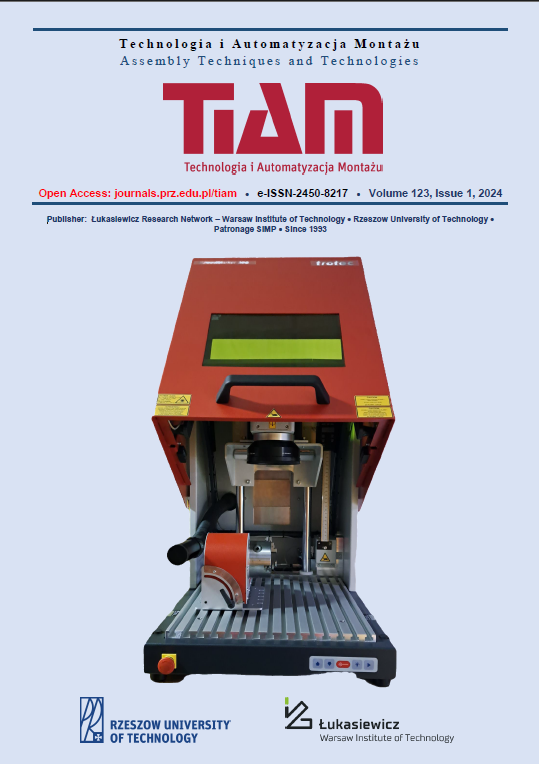Abstract
In the article, research was carried out to determine the impact of the TiBW anti-wear coating on the operational properties of cutting tools for machining nickel alloys. The dynamics of tool wear were determined based on changes in the components of the total cutting force, microscopic observation of wear on the flank surface, and observation of wear based on SEM images. The condition of the technological surface layer was also determined in the form of changes in the microstructure morphology and hardening of the surface layer. The research was compared to a reference tool with the same geometry with an AlTiN coating. It was shown, among other things, that TiBW coatings can be used successfully for cutting tools for machining nickel alloys, and that the wear dynamic is similar to those of tools with the AlTiN coating. The analyses confirmed the significant thermomechanical impact of the cutter during machining, manifested by chipping and a tendency to strengthen the processed material. Based on observations of the microstructure of the surface layer after processing, it was shown that the thermal conductivity of the TiBW coating may be lower than that of the AlTiN coating, which is reflected in the different depths of the thermomechanical interaction zones.
References
Bergs, T., Hardt, M., & Schraknepper, D. (2020). Investigations on the Influence of the Cemented Carbide Grade on the Surface Integrity when End Milling DA 718. Procedia CIRP, 93, 1490–1495. https://doi.org/10.1016/J.PROCIR.2020.03.068
Buddaraju, K. M., Ravi Kiran Sastry, G., & Kosaraju, S. (2021). A review on turning of Inconel alloys. Materials Today: Proceedings, 44, 2645–2652. https://doi.org/10.1016/J.MATPR.2020.12.673
De Bartolomeis, A., Newman, S. T., Jawahir, I. S., Biermann, D., & Shokrani, A. (2021). Future research directions in the machining of Inconel 718. In Journal of Materials Processing Technology (Vol. 297). Elsevier Ltd. https://doi.org/10.1016/j.jmatprotec.2021.117260
Guimaraes, M. C. R., Fogagnolo, J. B., Paiva, J. M., Veldhuis, S., & Diniz, A. E. (2023). The impact of the cutting parameters and tool condition on surface integrity when milling Inconel 625. Journal of Materials Research and Technology, 25, 1944–1958. https://doi.org/10.1016/j.jmrt.2023.06.071
Hadi, M. A., Ghani, J. A., Che Haron, C. H., & Kasim, M. S. (2013). Comparison between up-milling and down-milling operations on tool wear in milling Inconel 718. Procedia Engineering, 68, 647–653. https://doi.org/10.1016/j.proeng.2013.12.234
Kosaraju, S., Vijay Kumar, M., & Sateesh, N. (2018). Optimization of Machining Parameter in Turning Inconel 625. Materials Today: Proceedings, 5(2), 5343–5348. https://doi.org/10.1016/j.matpr.2017.12.119
Li, H. Z., Zeng, H., & Chen, X. Q. (2006). An experimental study of tool wear and cutting force variation in the end milling of Inconel 718 with coated carbide inserts. Journal of Materials Processing Technology, 180(1–3), 296–304. https://doi.org/10.1016/j.jmatprotec.2006.07.009
Lotfi, M., Jahanbakhsh, M., & Akhavan Farid, A. (2016). Wear estimation of ceramic and coated carbide tools in turning of Inconel 625: 3D FE analysis. Tribology International, 99, 107–116. https://doi.org/10.1016/j.triboint.2016.03.008
Parida, A. K., & Maity, K. (2018). Comparison the machinability of Inconel 718, Inconel 625 and Monel 400 in hot turning operation. Engineering Science and Technology, an International Journal, 21(3), 364–370. https://doi.org/10.1016/j.jestch.2018.03.018
Parida, A. K., & Maity, K. (2019). FEM analysis and experimental investigation of force and chip formation on hot turning of Inconel 625. Defence Technology, 15(6), 853–860. https://doi.org/10.1016/j.dt.2019.04.012
Paturi, U. M. R., B., V. D., & Reddy, N. S. (2021). Progress of machinability on the machining of Inconel 718: A comprehensive review on the perception of cleaner machining. Cleaner Engineering and Technology, 5, 100323. https://doi.org/10.1016/J.CLET.2021.100323
Pedroso, A. F. V., Sousa, V. F. C., Sebbe, N. P. V., Silva, F. J. G., Campilho, R. D. S. G., Sales-Contini, R. C. M., & Jesus, A. M. P. (2023). A Comprehensive Review on the Conventional and Non-Conventional Machining and Tool-Wear Mechanisms of INCONEL®. In Metals (Vol. 13, Issue 3). MDPI. https://doi.org/10.3390/met13030585
Sørby, K., & Vagnorius, Z. (2018). High-pressure cooling in turning of inconel 625 with ceramic cutting tools. Procedia CIRP, 77, 74–77. https://doi.org/10.1016/j.procir.2018.08.221
Tanaka, Y., Sato, H., & Eryu, O. (2022). Improved cemented carbide tool edge formed by solid phase chemical–mechanical polishing. Journal of Materials Research and Technology, 20, 606–615. https://doi.org/10.1016/J.JMRT.2022.07.077
Waghmode, S. P., & Dabade, U. A. (2019). Optimization of process parameters during turning of Inconel 625. Materials Today: Proceedings, 19, 823–826. https://doi.org/10.1016/j.matpr.2019.08.138
Yıldırım, Ç. V. (2019). Experimental comparison of the performance of nanofluids, cryogenic and hybrid cooling in turning of Inconel 625. Tribology International, 137, 366–378. https://doi.org/10.1016/J.TRIBOINT.2019.05.014


